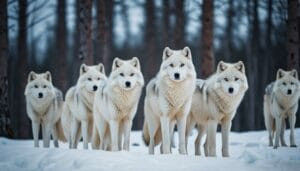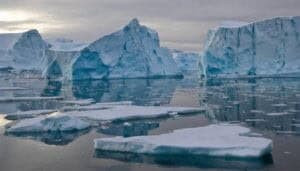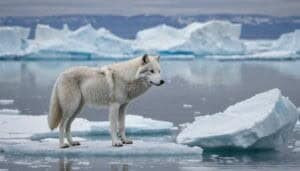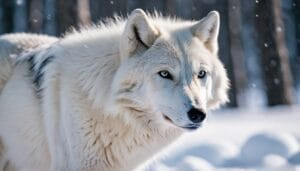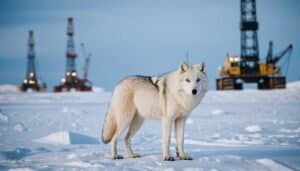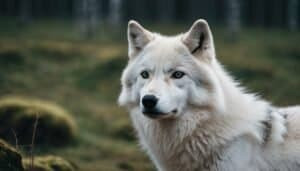Introduction
Changes in vegetation patterns due to climate change significantly impact Arctic wolves, influencing their prey availability, hunting behaviors, and reproductive success
This article explores these effects, detailing the specific vegetation changes occurring in the Arctic and the adaptive strategies Arctic wolves employ to cope with these changes. Additionally, we will examine the broader role of Arctic wolves in the ecosystem and how these vegetation shifts affect their interactions with other species
The Impact of Vegetation Changes on Arctic Wolves
Changes in vegetation patterns due to climate change have profound implications for Arctic wolves. These effects manifest in several critical ways, including prey availability, hunting behaviors, and reproductive success
Understanding these impacts helps to illuminate the broader consequences of climate change on Arctic ecosystems
Effects on Prey Availability
One of the primary ways vegetation changes impact Arctic wolves is through the availability of their prey. Arctic wolves primarily hunt herbivores such as musk oxen, Arctic hares, and caribou, all of which depend on vegetation for food
As climate change alters the distribution and abundance of vegetation, the populations of these herbivores can fluctuate significantly
For instance, warmer temperatures can lead to the encroachment of shrubs and other plants into areas traditionally dominated by lichens and mosses. These changes can negatively affect the food sources for caribou, which rely heavily on lichens during winter months
A decline in caribou populations directly impacts Arctic wolves, reducing their primary food source and forcing them to expend more energy in hunting scarce prey
Changes in Hunting Behaviors
Alterations in vegetation patterns also compel Arctic wolves to adapt their hunting strategies. In areas where vegetation becomes denser, visibility and mobility for both predators and prey are affected
Wolves may need to alter their traditional pack-hunting techniques to navigate through thicker vegetation or to chase prey that now has more hiding spots
For example, the expansion of shrublands into tundra areas can create more obstacles for wolves, making it harder for them to chase down prey. Consequently, wolves might need to hunt in smaller packs or rely more on stealth and ambush tactics rather than the high-speed pursuits they are known for in open tundra
Influence on Reproductive Success
The reproductive success of Arctic wolves is closely tied to the availability of prey, which is, in turn, influenced by vegetation patterns
Adequate food supply is crucial for the health of pregnant females and the survival of their pups. When vegetation changes reduce prey availability, it can lead to lower birth rates and higher mortality rates among wolf pups
Research indicates that in years with poor prey availability due to vegetation changes, wolf litters tend to be smaller, and pup survival rates drop. Additionally, female wolves in poor health due to inadequate nutrition are less likely to reproduce successfully. This cascading effect highlights the interconnectedness of vegetation, prey, and predator dynamics in Arctic ecosystems
Specific Vegetation Changes in the Arctic
Climate change is driving significant alterations in Arctic vegetation, impacting both flora and fauna in the region. Understanding the specific types of vegetation changes, their extent, and the climate factors driving these shifts is crucial for comprehending their broader ecological impacts
Types of Vegetation Affected
The Arctic tundra, traditionally characterized by low-growing plants such as lichens, mosses, and grasses, is witnessing a noticeable shift in its vegetation composition. Warmer temperatures and longer growing seasons are promoting the expansion of shrubs and woody plants into areas that were once dominated by tundra species
For example, species such as dwarf birch and willow are increasingly encroaching into these regions, altering the landscape
This shrub expansion can disrupt the delicate balance of the tundra ecosystem. Herbivores like caribou, which depend on lichens and grasses, may find their primary food sources diminishing. This shift not only affects herbivore populations but also the predators that rely on them, including Arctic wolves
Extent and Rate of Vegetation Change
The rate of vegetation change in the Arctic is alarming. Studies have shown that Arctic temperatures are rising at twice the global average rate, leading to rapid ecological shifts
The extent of shrub encroachment has been significant, with some areas experiencing a 20% increase in shrub cover over the past few decades. This accelerated change poses a challenge for Arctic species to adapt swiftly enough to the new conditions
Furthermore, permafrost thawing is another factor contributing to vegetation change. As the ground thaws, it creates wetter conditions, promoting the growth of certain plant species over others. This change in soil moisture can further alter plant community compositions, impacting the entire food web
Climate Factors Driving Vegetation Change
Several climate factors are driving these vegetation changes in the Arctic. Rising temperatures, altered precipitation patterns, and increased frequency of extreme weather events all play a role
Warmer temperatures extend the growing season, allowing plants that previously could not survive in the harsh Arctic climate to thrive
Changes in precipitation also affect vegetation. Increased rainfall can promote the growth of shrubs and grasses, while altered snowfall patterns can impact plant survival and growth. Extreme weather events, such as heatwaves and storms, can cause sudden shifts in vegetation by damaging existing plant life and creating opportunities for different species to take root
The combined effect of these climate factors is a dynamic and rapidly changing Arctic landscape. These changes have profound implications for the species that inhabit these regions, particularly Arctic wolves, which must navigate and adapt to a transforming ecosystem
Adaptive Strategies of Arctic Wolves
As climate change alters the Arctic environment, Arctic wolves must adapt to survive. These adaptations encompass behavioral changes, dietary shifts, and modified migration patterns. Understanding these adaptive strategies provides insight into the resilience of Arctic wolves and the challenges they face
Behavioral Adaptations
Arctic wolves exhibit various behavioral adaptations in response to changing vegetation and prey availability. One significant adaptation is altering their hunting strategies. In areas where shrub cover has increased, wolves may rely more on stealth and ambush techniques rather than open chases
This shift requires wolves to become more patient and strategic hunters, utilizing the increased cover to their advantage
Pack dynamics may also change as a behavioral adaptation. In environments with scarce prey, wolves may hunt in smaller groups to reduce competition for limited resources. This can lead to more solitary hunting or smaller, more flexible pack structures
Additionally, wolves might expand their territory ranges in search of food, which can increase encounters with other packs and lead to territorial disputes
Dietary Shifts
With prey populations fluctuating due to vegetation changes, Arctic wolves may adjust their diets to include a broader range of food sources. While their primary diet consists of large herbivores like caribou and musk oxen, they may increasingly hunt smaller mammals, birds, and even scavenge more frequently
This dietary flexibility is crucial for their survival in a rapidly changing environment
In some regions, Arctic wolves have been observed preying more on Arctic hares, lemmings, and other small mammals as larger prey becomes scarce. They may also consume more plant material, such as berries, to supplement their diet when animal prey is not readily available
This dietary shift can help maintain their energy levels and overall health in the face of declining traditional prey species
Migration Patterns
Climate-induced changes in vegetation and prey distribution can also lead to altered migration patterns for Arctic wolves. As prey animals like caribou shift their migration routes in response to changing food availability and habitat conditions, wolves must follow these new routes to sustain their food supply
In some cases, Arctic wolves may migrate greater distances or move into previously uninhabited areas in search of prey. This increased mobility can expose wolves to new environmental challenges and interactions with other predator species
Additionally, changes in sea ice patterns due to warming temperatures can affect the ability of wolves to travel across frozen landscapes, further influencing their migration and hunting behaviors
The ability of Arctic wolves to adapt their behaviors, diets, and migration patterns is a testament to their resilience. However, the rapid pace of climate change presents significant challenges, and the long-term survival of Arctic wolves will depend on their capacity to continue adapting to the evolving Arctic landscape
The Role of Arctic Wolves in the Ecosystem
Arctic wolves play a crucial role in the Arctic ecosystem, influencing both the population dynamics of their prey and the overall health of the vegetation. Their interactions with other species and their impact on vegetation balance highlight their importance in maintaining ecological stability
Predator-Prey Dynamics
Arctic wolves are apex predators in their environment, meaning they have no natural predators and play a critical role in controlling the population sizes of their prey species. By preying on herbivores like caribou, musk oxen, and Arctic hares, wolves help to regulate these populations, preventing overgrazing and ensuring that vegetation communities remain balanced
The presence of wolves can also create a “landscape of fear” for herbivores, influencing their grazing patterns
Herbivores may avoid certain areas where wolf predation risk is high, allowing vegetation in these areas to recover and thrive. This dynamic helps maintain a diverse and healthy plant community, which is essential for the overall ecosystem
Impact on Vegetation Balance
Arctic wolves indirectly affect vegetation through their predation on herbivores. By keeping herbivore populations in check, wolves help prevent overgrazing, which can lead to soil erosion and degradation of plant communities
This balance is crucial, especially in the fragile Arctic environment where vegetation recovery can be slow due to harsh climatic conditions
For example, in areas where wolf populations have declined, herbivore populations can grow unchecked, leading to overgrazing and subsequent damage to tundra vegetation. This can result in a loss of plant biodiversity and negatively impact the entire ecosystem
By maintaining a healthy balance between predators and prey, wolves play a vital role in sustaining the integrity of Arctic habitats
Interactions with Other Species
The presence of Arctic wolves also influences the behavior and population dynamics of other species within the ecosystem. For instance, the predation pressure exerted by wolves can affect the distribution and behavior of mesopredators such as Arctic foxes. These smaller predators may change their hunting strategies or territories to avoid encounters with wolves
Additionally, wolves contribute to the ecosystem as scavengers. Carcasses left behind by wolves provide a food source for a variety of scavenging species, including birds, other mammals, and even insects. This nutrient cycling helps support a diverse array of organisms and promotes ecological resilience
Wolves’ interactions with their environment and other species illustrate their integral role in the Arctic ecosystem. They help maintain the balance between predator and prey populations, support vegetation health, and contribute to the overall biodiversity of the region
As climate change continues to alter the Arctic landscape, the role of Arctic wolves in maintaining ecological stability becomes even more critical
Conclusion
Arctic wolves are vital to the Arctic ecosystem, profoundly influenced by climate-induced changes in vegetation patterns. These changes affect prey availability, hunting behaviors, and reproductive success, forcing wolves to adapt their behaviors, diets, and migration patterns
As apex predators, they regulate herbivore populations, preventing overgrazing and maintaining vegetation balance, which is crucial for the overall health of the ecosystem. Their interactions with other species further underscore their ecological significance
Understanding these dynamics highlights the importance of conservation efforts to protect Arctic wolves and their habitat as climate change continues to reshape the Arctic landscape


